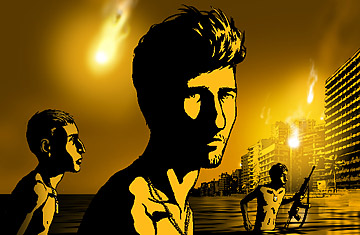
Some memories are like the rubble in a city strafed and scarred by war. Reconnoitering into the past, we pick through the debris, eager to know old truths but fearful of what we may find. Some people choose psychoanalysis to make this treacherous journey. The documentary director Ari Folman did it with Waltz with Bashir, a film he hoped would locate and purge the demons of his Israeli Army service in Lebanon in 1982.
The film is fascinating in many ways — as a research project, a detective thriller, an explosive action adventure, but most notably as an animated feature. Bashir goes against the dominant grain of Disney, with talking animals and adorable optimism, and is distinct even from last year's Iranian memoir Persepolis, which found saving humor in a girl-coming-of-age story. In Folman's film the only animals are wild dogs and slaughtered horses; the only children are victims of war or underage warriors themselves. A dead serious film occasionally leavened with gallows humor, Bashir probes the lingering, subterranean effects of war on the director and some old friends.
A quarter-century after the fact, these former soldiers are still disturbed by the massacre of Palestinians in the Sabra and Shatila refugee camps, at the hands of Christian Phalangists furious that their leader, Bashir Gemayel, has been killed. One friend tells Folman of a recurring nightmare: 26 wild hounds gallop through a town and stop to howl menacingly at the man's window. He explains that when Israeli soldiers neared a Lebanese town, dogs would bark at them alerting the locals to invaders, so his job was to shoot the dogs. They have returned from the dead to yelp in his sleep. The story spurs Folman, who has no conscious memory of his Lebanon tour, to wonder what war experiences he may have repressed. This leads him to interview other veterans of his brigade.
The movie was first shot as a regular video, then stylized (by Yoni Goodman) into its current form, using three forms of animation: Flash, old-fashioned cel and state-of-the-art CGI. The look is spare and evocative, with simple renderings of the conversations that splash into hallucinatory images of the soldiers emerging naked from the sea, a man finding refuge on that sea in the raftlike body of a huge, beautiful woman. The actual memories are searing enough for some ex-soldiers: being trapped in a tank under enemy fire, or hiding behind a rock when all his comrades have been killed, or watching a family pinned against a wall and gunned down.
Folman's background is in documentary films, plus a stint writing for the 2005 Israeli miniseries that was adapted for HBO this year as In Treatment. (He wrote three episodes for the series' haunted soldier, who was played by Assi Dayan, the son of Defense Minister and war hero Moshe Dayan.) Like generations of Israelis, Folman grew up in a country that is besieged by hostile neighbors even as it occupies land the Palestinians consider their own. That twin feeling, of being both prisoners and police, might give anyone restless dreams. Further, Folman's parents' history as Auschwitz survivors gives him a kinship to the detainees in the Lebanon camps. So the soldiers whose commanders did nothing to stop the 1982 massacre — while women, children and the elderly were led out of the camps begging for help — are especially susceptible to long-term remorse.
Though the war was decades ago, and the combatants middle-Eastern, the issues the film raises are in no way provincial. Waltz with Bashir should touch all those who see it — both the vast majority who have been raised on gung-ho war movies and the small minority who find that the truth is the opposite of the fiction. "It's like nothing you've seen in American movies," Folman has said. "No glam, no glory. Just very young men going nowhere, shooting at no one they know, getting shot by no one they know, then going home and trying to forget. Sometimes they can. Most of the time they cannot."
In this sense, the movie might have been made about Americans today. We can debate the toxic consequences of the U.S. occupation of Iraq, but an equally troubling question is the effect of the Iraq occupation on U.S. soldiers. The dreadful nature of that conflict hasn't touched most Americans. Its troops alone bear the scar of war; they carry it home with them — if they come home — and those nightmares may never end. Waltz with Bashir is about the cold fingers of memory that clutch the heart. Folman's exemplary film says that only by exposing the wounds can they begin to heal. The message of the futility of war has rarely been painted with such bold strokes.
At the end, underlining the corrosive realism of these nightmares, the film drops its veneer of animation and switches to newsreel footage of the massacre's victims — their bodies dumped like refuse on the streets, the head of one child sticking out of the devastation like a discarded life-size doll. That child had no more nightmares to trouble her. But for viewers, no less than for Folman, Waltz with Bashir is a haunting, cleansing experience.